Individual motivation (theory)
动机与情绪理论知识点
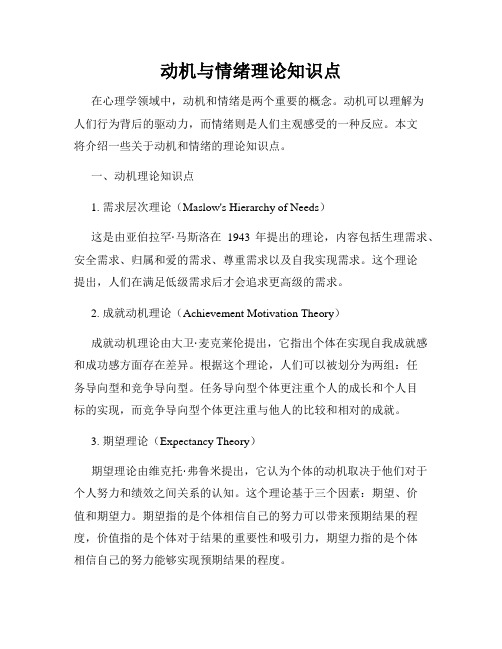
动机与情绪理论知识点在心理学领域中,动机和情绪是两个重要的概念。
动机可以理解为人们行为背后的驱动力,而情绪则是人们主观感受的一种反应。
本文将介绍一些关于动机和情绪的理论知识点。
一、动机理论知识点1. 需求层次理论(Maslow's Hierarchy of Needs)这是由亚伯拉罕·马斯洛在1943年提出的理论,内容包括生理需求、安全需求、归属和爱的需求、尊重需求以及自我实现需求。
这个理论提出,人们在满足低级需求后才会追求更高级的需求。
2. 成就动机理论(Achievement Motivation Theory)成就动机理论由大卫·麦克莱伦提出,它指出个体在实现自我成就感和成功感方面存在差异。
根据这个理论,人们可以被划分为两组:任务导向型和竞争导向型。
任务导向型个体更注重个人的成长和个人目标的实现,而竞争导向型个体更注重与他人的比较和相对的成就。
3. 期望理论(Expectancy Theory)期望理论由维克托·弗鲁米提出,它认为个体的动机取决于他们对于个人努力和绩效之间关系的认知。
这个理论基于三个因素:期望、价值和期望力。
期望指的是个体相信自己的努力可以带来预期结果的程度,价值指的是个体对于结果的重要性和吸引力,期望力指的是个体相信自己的努力能够实现预期结果的程度。
二、情绪理论知识点1. 六种基本情绪(Six Basic Emotions)根据保罗·艾克曼和沃利特·弗里曼的研究,情绪可以分为六种基本类型:喜悦、恐惧、愤怒、厌恶、悲伤和惊讶。
这些基本情绪是人类共通的,不受文化差异的影响。
2. 情绪调节理论(Emotion Regulation Theory)情绪调节理论认为,情绪不仅仅是自发产生的,个体也可以通过调节策略来主动管理和改变自己的情绪。
情绪调节策略可以分为表面策略(如冷静表情)和深层策略(如让自己平静下来)。
3. 情绪智力(Emotional Intelligence)情绪智力是指个体管理自己的情绪、理解他人的情绪以及有效应对情绪的能力。
黄希庭心理学笔记之课后名词解释完整版
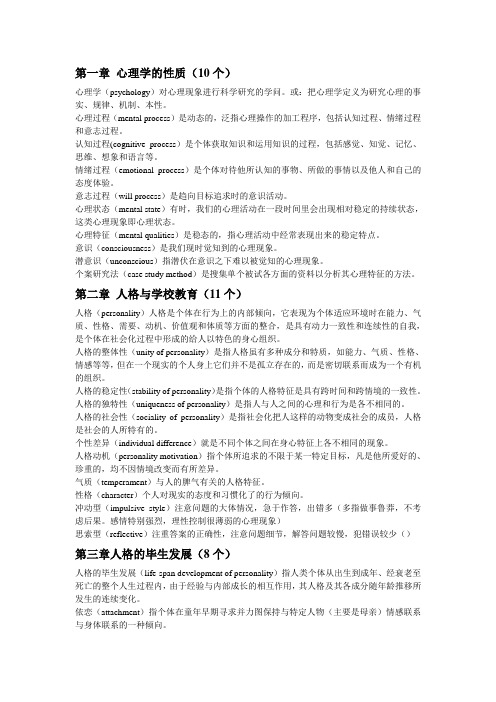
第一章心理学的性质(10个)心理学(psychology)对心理现象进行科学研究的学问。
或:把心理学定义为研究心理的事实、规律、机制、本性。
心理过程(mental process)是动态的,泛指心理操作的加工程序,包括认知过程、情绪过程和意志过程。
认知过程(cognitive process)是个体获取知识和运用知识的过程,包括感觉、知觉、记忆、思维、想象和语言等。
情绪过程(emotional process)是个体对待他所认知的事物、所做的事情以及他人和自己的态度体验。
意志过程(will process)是趋向目标追求时的意识活动。
心理状态(mental state)有时,我们的心理活动在一段时间里会出现相对稳定的持续状态,这类心理现象即心理状态。
心理特征(mental qualities)是稳态的,指心理活动中经常表现出来的稳定特点。
意识(consciousness)是我们现时觉知到的心理现象。
潜意识(unconscious)指潜伏在意识之下难以被觉知的心理现象。
个案研究法(case study method)是搜集单个被试各方面的资料以分析其心理特征的方法。
第二章人格与学校教育(11个)人格(personality)人格是个体在行为上的内部倾向,它表现为个体适应环境时在能力、气质、性格、需要、动机、价值观和体质等方面的整合,是具有动力一致性和连续性的自我,是个体在社会化过程中形成的给人以特色的身心组织。
人格的整体性(unity of personality)是指人格虽有多种成分和特质,如能力、气质、性格、情感等等,但在一个现实的个人身上它们并不是孤立存在的,而是密切联系而成为一个有机的组织。
人格的稳定性(stability of personality)是指个体的人格特征是具有跨时间和跨情境的一致性。
人格的独特性(uniqueness of personality)是指人与人之间的心理和行为是各不相同的。
Motivation Theory(英文版)(ppt 17页)
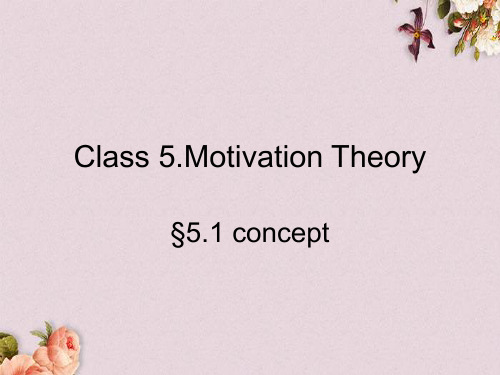
1.Hierarchy of Needs Theory
Abraham Maslow
• There is a hierarchy of 5 needs---physiological, safety,social,esteem,& self-actualization---and as each need is sequentially satisfied,the next need becomes dominant
• Need:some internal state that makes certain
outcomes appear attractive • Process:unsatisfied need---tension---drives---
search behavior---satisfied need----reduction of tension
• Maslow: a rigid steplike progression. ERG:contains a frustration-regression dimension
• Several studies have supported the ERG theory:natives of Spain & Japan place social needs before their physiological requirements
3.Cognitive Evaluation Theory
may be relevant to that set of jobs that falls in between--neither extremely dull nor intersting
心理学中八种关于动机的理论

心理学中八种关于动机的理论1、成就动机指个体在追求目标时所表现出的积极性和努力程度。
2、XXX:成就动机是人类需要层次中的一种,是指个体追求自我实现和发挥潜能的渴望。
3、XXX:成就动机是由于个体对于成功的需要和对于失败的恐惧而产生的。
4、成就动机的激发:4.1目标的明确性和挑战性,目标越明确和越具有挑战性,激发成就动机的可能性就越大。
4.2反馈的及时性和准确性,个体需要得到及时和准确的反馈,以便调整自身的行为。
4.3自主性和控制感,个体需要感到自己对于结果的控制权和决定权,才能更好地激发成就动机。
5、成就动机的应用:5.1制定明确和具有挑战性的目标,同时提供适当的支持和反馈。
5.2提高个体的自主性和控制感,让他们感到自己对于结果有一定的掌控能力。
5.3鼓励个体追求自我实现和发挥潜能的渴望,提高其对于成功的需要和对于失败的恐惧的认识。
五)期望理论1、期望理论指个体在决策时会考虑到行动的结果和可能性,并根据这些来选择最优的行动方案。
2、期望值的计算:2.1期望值=行动结果的价值×实现的可能性2.2价值和可能性的评估需要考虑到个体的主观感受和经验。
3、期望理论的应用:3.1提高个体对于目标实现的期望值,可以通过提高目标的价值或增加实现的可能性来实现。
3.2降低个体对于目标实现的期望值,可以通过降低目标的价值或减少实现的可能性来实现。
3.3激励个体采取最优的行动方案,需要提高个体对于行动结果和可能性的评估准确性,并提供适当的激励措施。
六)自我决定理论1、自我决定理论指个体在行动时需要感到自己对于行动的选择和结果有一定的掌控和决定权。
2、自我决定理论的三种基本需求:2.1自主性,个体需要感到自己对于行动的选择和结果有一定的掌控和决定权。
2.2能力,个体需要感到自己具有完成行动所需的能力和技能。
2.3关系,个体需要感到自己与他人之间的关系和互动是积极的和有意义的。
3、自我决定理论的应用:3.1提高个体的自主性,可以通过提供选择权和决策权等方式来实现。
成就动机理论
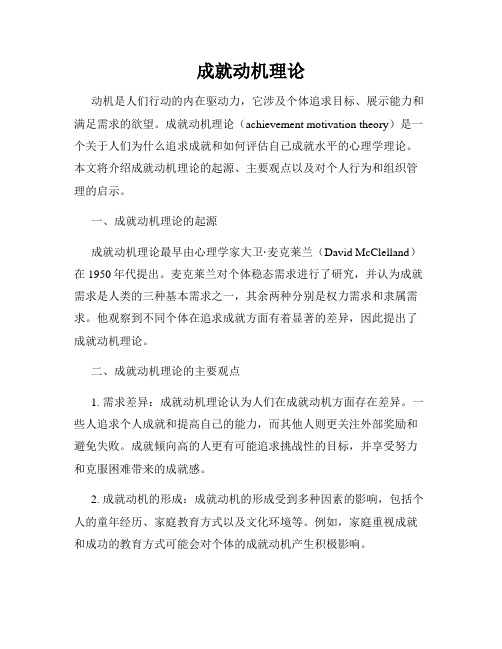
成就动机理论动机是人们行动的内在驱动力,它涉及个体追求目标、展示能力和满足需求的欲望。
成就动机理论(achievement motivation theory)是一个关于人们为什么追求成就和如何评估自己成就水平的心理学理论。
本文将介绍成就动机理论的起源、主要观点以及对个人行为和组织管理的启示。
一、成就动机理论的起源成就动机理论最早由心理学家大卫·麦克莱兰(David McClelland)在1950年代提出。
麦克莱兰对个体稳态需求进行了研究,并认为成就需求是人类的三种基本需求之一,其余两种分别是权力需求和隶属需求。
他观察到不同个体在追求成就方面有着显著的差异,因此提出了成就动机理论。
二、成就动机理论的主要观点1. 需求差异:成就动机理论认为人们在成就动机方面存在差异。
一些人追求个人成就和提高自己的能力,而其他人则更关注外部奖励和避免失败。
成就倾向高的人更有可能追求挑战性的目标,并享受努力和克服困难带来的成就感。
2. 成就动机的形成:成就动机的形成受到多种因素的影响,包括个人的童年经历、家庭教育方式以及文化环境等。
例如,家庭重视成就和成功的教育方式可能会对个体的成就动机产生积极影响。
3. 成就目标的设置:成就动机理论指出,个体会自主设定适度挑战性的目标,这些目标既能激发他们的兴趣和动力,又可以提高他们的表现水平。
相比于容易达成的目标,具有一定挑战性的目标能够更好地激发个体的成就动机。
4. 成就动机的评价:个体对自己的成就水平进行评价时,会参考内在标准和外部标准。
内在标准是个体对自己的期望和标准,而外部标准是他人的评价和反馈。
个体与内在标准一致的成就会带来满足感和自我肯定,而与外部标准一致的成就会带来赞扬和认可。
三、成就动机理论对个人行为的启示成就动机理论对个人行为产生了重要的启示。
首先,了解个体成就动机的差异有助于更好地理解他们的行为和决策。
一些个体可能更愿意承担挑战性的任务,而另一些个体可能更注重稳定性和安全性。
motivation短语搭配
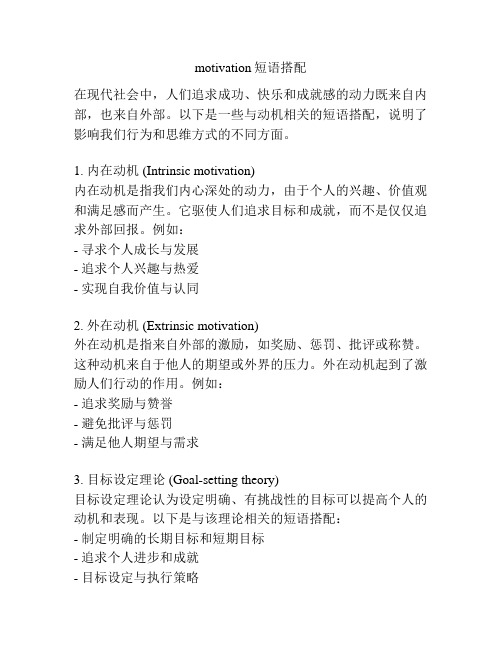
motivation短语搭配在现代社会中,人们追求成功、快乐和成就感的动力既来自内部,也来自外部。
以下是一些与动机相关的短语搭配,说明了影响我们行为和思维方式的不同方面。
1. 内在动机 (Intrinsic motivation)内在动机是指我们内心深处的动力,由于个人的兴趣、价值观和满足感而产生。
它驱使人们追求目标和成就,而不是仅仅追求外部回报。
例如:- 寻求个人成长与发展- 追求个人兴趣与热爱- 实现自我价值与认同2. 外在动机 (Extrinsic motivation)外在动机是指来自外部的激励,如奖励、惩罚、批评或称赞。
这种动机来自于他人的期望或外界的压力。
外在动机起到了激励人们行动的作用。
例如:- 追求奖励与赞誉- 避免批评与惩罚- 满足他人期望与需求3. 目标设定理论 (Goal-setting theory)目标设定理论认为设定明确、有挑战性的目标可以提高个人的动机和表现。
以下是与该理论相关的短语搭配:- 制定明确的长期目标和短期目标- 追求个人进步和成就- 目标设定与执行策略4. 自我效能 (Self-efficacy)自我效能是指个体对于自己能够成功完成任务的信心和能力评估。
以下是与自我效能相关的短语搭配:- 培养积极的自我影像与信念- 发展有效的解决问题的能力- 建立持久的毅力和耐力5. 动力理论 (Motivation theory)动力理论研究了人类行为中各种驱动力的形成和影响。
以下是与动力理论相关的短语搭配:- 满足生理和心理需求- 寻求刺激与挑战- 追求成就和认可6. 团队动力 (Team motivation)团队的动力是指团队中成员合作的共同目标和激励方式。
以下是与团队动力相关的短语搭配:- 建立团队合作和信任- 鼓励团队精神和互助精神- 分享成功和反思失败总的来说,人类的动机可以来自内在也可以来自外在,通过设定明确的目标、培养自我效能和满足各种需求来提高动力。
ted演讲inside the mind of中英对照
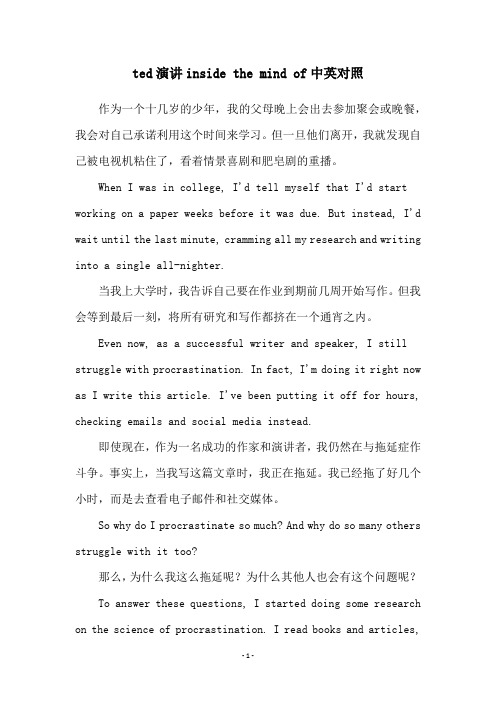
ted演讲inside the mind of中英对照作为一个十几岁的少年,我的父母晚上会出去参加聚会或晚餐,我会对自己承诺利用这个时间来学习。
但一旦他们离开,我就发现自己被电视机粘住了,看着情景喜剧和肥皂剧的重播。
When I was in college, I'd tell myself that I'd start working on a paper weeks before it was due. But instead, I'd wait until the last minute, cramming all my research and writing into a single all-nighter.当我上大学时,我告诉自己要在作业到期前几周开始写作。
但我会等到最后一刻,将所有研究和写作都挤在一个通宵之内。
Even now, as a successful writer and speaker, I still struggle with procrastination. In fact, I'm doing it right now as I write this article. I've been putting it off for hours, checking emails and social media instead.即使现在,作为一名成功的作家和演讲者,我仍然在与拖延症作斗争。
事实上,当我写这篇文章时,我正在拖延。
我已经拖了好几个小时,而是去查看电子邮件和社交媒体。
So why do I procrastinate so much? And why do so many others struggle with it too?那么,为什么我这么拖延呢?为什么其他人也会有这个问题呢? To answer these questions, I started doing some research on the science of procrastination. I read books and articles,I watched TED talks and YouTube videos. And what I discovered is that procrastination isn't just a bad habit or a lack of willpower. It's a complex psychological behavior with deep roots in our brains.为了回答这些问题,我开始研究拖延症的科学。
《人的动机理论》(Thetheoryofhumanmotivation)
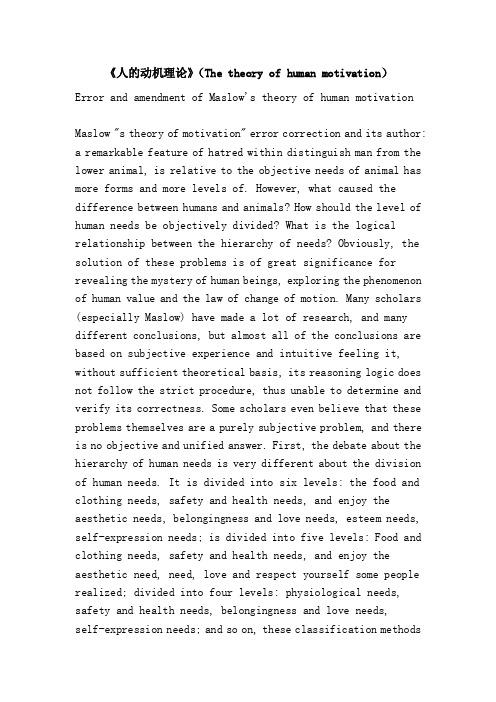
《人的动机理论》(The theory of human motivation)Error and amendment of Maslow's theory of human motivationMaslow "s theory of motivation" error correction and its author: a remarkable feature of hatred within distinguish man from the lower animal, is relative to the objective needs of animal has more forms and more levels of. However, what caused the difference between humans and animals? How should the level of human needs be objectively divided? What is the logical relationship between the hierarchy of needs? Obviously, the solution of these problems is of great significance for revealing the mystery of human beings, exploring the phenomenon of human value and the law of change of motion. Many scholars (especially Maslow) have made a lot of research, and many different conclusions, but almost all of the conclusions are based on subjective experience and intuitive feeling it, without sufficient theoretical basis, its reasoning logic does not follow the strict procedure, thus unable to determine and verify its correctness. Some scholars even believe that these problems themselves are a purely subjective problem, and there is no objective and unified answer. First, the debate about the hierarchy of human needs is very different about the division of human needs. It is divided into six levels: the food and clothing needs, safety and health needs, and enjoy the aesthetic needs, belongingness and love needs, esteem needs, self-expression needs; is divided into five levels: Food and clothing needs, safety and health needs, and enjoy the aesthetic need, need, love and respect yourself some people realized; divided into four levels: physiological needs, safety and health needs, belongingness and love needs,self-expression needs; and so on, these classification methodsare lack of necessary theoretical basis. At present, people generally accepted the theory of human motivation put forward by American psychologist Maslow in 50s". He divides human needs into five levels: physiological needs, safety needs, love needs, respect needs, and self actualization needs. However, Maslow did not discuss why his division, this division method is not based on logical reasoning, more is based on their perceptual experience, lack of necessary theoretical basis, people cannot use the theory to affirm it or deny it, but according to practical experience and intuitive sense of it. It is not difficult to find, this division is the main method of different external characteristic parameters according to different needs in the process of human survival and development has (such as importance, persistence, extensive and profound) to carry out, and these differences in external characteristic parameters which can not accurately reflect the intrinsic logic relation between the various needs. Obviously, the division level must be in accordance with the need of internal factors that need to objective causes, can correctly reflect the intrinsic logic relation between the various needs, the resulting "needs theory" or "motivation theory" is objective and scientific. The author believes that human needs should be divided and divided into four levels, namely, food and clothing, health and safety, self-esteem and respect, self development and self actualization needs. This conclusion is consistent with Maslow's theory of motivation comparison, the main difference is: love need not classified as a level, to a level, with respect to need, respect need can be divided into works in the opposite direction of the two aspects of the need for self-esteem and respect need. I also think, can not be "aesthetic and enjoy" alone into a hierarchy, and because theaesthetic enjoyment is in need to be generated to meet after the emotional experience, it is not an objective need, but a subjective reflection of all forms and all levels of needs are met in all it will make people produce emotional experience and aesthetic enjoyment. Two, the theoretical basis of the division of human needs hierarchy, to know how to divide the hierarchy of needs, we must first understand the objective nature of needs. According to the theory of unified value, the objective essence of human needs is the value demanded by the human subject for the improvement of its essential force, and for the individual,In order to improve their ability to work, the value of the use of living materials requirements. Generally speaking, people's consumption of various subsistence motive is to meet various subjective desires or their subjective and objective need, is to maintain and develop their own ability to work, the objective is to direct motive potential labor itself accumulate necessary machine. Practice shows that different types of living materials satisfy people's different levels of subjective needs, and form different levels of labor potential, and serve the different levels of labor ability. Therefore, the hierarchical structure of labor ability determines the structure of labor potential, the hierarchical structure of labor potential determines the structure of life information, life information hierarchy determines the hierarchy of human needs. The ability to work can be divided into four basic levels: 1, the bio chemical reaction ability ", is based on energy metabolism rate of the main scale, reflects the ability for the use of food energy and its substitute. 2, the "individual labor ability", which is the physical, mental and physical strength, complexity and proficiency as the main scale, reflects theability of people to the nature of various physical, chemical and biological nature and strength. 3, the "social work", which is the social influence (such as power, prestige, reputation and personality etc.) as the main scale, reflects the people for social law and social power ability. 4, the "ideal labor ability", which is the force of faith (such as religious belief, outlook on life and world view) as the main scale, reflects the people for social progress and the law of human development and power control ability. According to the four different levels of labor ability, labor potential can be divided into four basic types, means of subsistence is correspondingly divided into four basic types, the subjective need is accordingly divided into four basic levels. Three, the four basic types of labor potential (I) physiological labor potential. The part of labor potential that is used to maintain and develop people's "biochemical reaction ability" is called "physiological labor potential". All human activities are based on the basic biochemical reactions, and only with the basic biochemical reaction ability, people can have more advanced behavior and thinking ability. Biochemical reactions in organisms can exhibit organisms for external energy exchange, is the biological chemical reaction can use total quantity to describe energy metabolism, biochemical reaction ability can be used to describe the energy metabolism rate. The physiological potential of labor is the accumulation of people's consumption of physiological living materials (such as food, air, water, salt, clothes, etc.). The physiological data is based on the life of food energy as the core, all other non food energy in the form of physical life can be replaced by the food energy to a certain extent and compensation, physical labor potential generated can be converted into certain food energy. (two)individual labor potential. The labor potential that is used to maintain and develop the individual labor ability is called the individual labor potential. In the physiological condition of the natural environment and people in general, not all physical labor potential can eventually transformed into individual actual labor potential, this is because human life is limited, any person at any time are possible because of security reasons for health reasons inside and outside and the loss of their labor ability, failure rate is the accumulation of personal physical labor potential there will always be a certain size. The failure rate is called the failure rate of life "(failure rate or physiology), it consists of two parts: the failure rate of internal life, it is made up of individual health state to decide; the failure rate of the external life, it is the safety performance by the individual to determine the natural environment. Therefore, the objective of individual labor ability is to improve the utilization rate of biochemical reaction ability, and the objective of individual labor potential is to improve the utilization rate of physiological labor potential.The living materials used to reduce the rate of human life failure are called health related living materials; the data used to reduce the failure rate of human external life are called safe living materials. For example, nutrients, security facilities, labor protection products, comfortable clothing, aesthetic works, elegant environment can maintain and improve people's health and environmental safety performance to a certain extent. (three) socialized labor potential. The part of labor potential that is used to maintain and develop "socialized labor capacity" is called socialized laborpotential. In the general social environment, not all of the individual labor potential can eventually transformed into the social recognition of the ability to work, this is because any individual will because of some internal and external, the labor positions can not completely match with the ability to work, or can not find the release ability of labor labor post, resulting in individual labor potential part of the failure and the failure rate of the waste, the accumulation of personal individual labor potential always do not match labor jobs have a certain size. The failure rate is referred to as the "social failure rate", it consists of two parts: the internal social failure rate, it is made up of individual preference for society to decide, depends on the size of the love and respect of others or the society; the external social failure rate, it is by choice Society for the individual to decide, depends on the size of the society for love and respect for the individual level. If a person has a higher degree of love and respect for society or others, he will be on every possible occasion actively for the society or others to contribute their strength, consciously put all their individual needs and social labor potential or others combine to achieve his best choice of labor jobs. In order to make the individual labor potential as much as possible into the society or others useful labor; if society has a higher degree of love and respect for the people, will provide jobs for him in all possible conditions, provide favorable conditions for his playing ability and cleverness, combine to make all of his individual labor potential as much as possible needs or the needs of others and the society, the individual labor potential as much as possible into social recognition Work ability. Therefore, the objective purpose of socialized labor ability is to improve the utilization rate of individuallabor capacity, and the objective objective of social labor potential is to improve the utilization rate of individual labor potential. The living materials used to reduce the internal social failure rate of people are called self esteem living materials; the living materials used to reduce the external social failure rate of human beings are called the life data of human dignity. For example, certificates, bonuses, honors, job titles, titles, etc., can reflect and change the respect for the individual to a certain extent, and can meet the needs of people for respect and respect. (four) ideal labor potential. The part of labor potential that is used to maintain and develop "idealized labor capacity" is called idealized labor potential. In the general social and historical conditions, not all of the social labor potential can eventually transformed into useful for the survival and development of human labor ability, really for human progress and social development, this is because any society will exist various social ills in any historical period, such as corruption, rigid thinking, unfair distribution, these social ills will guide social labor potential investment unreasonable production and consumption caused by the loss and waste, the reasons for internal and external social association, part of the social labor potential does not comply with the development of human beings and society really need or want. There is a certain size and the failure rate, the failure rate is called the "ideal failure rate", it is by the society for the ideal goal of human choice tendency The size of the decision depends on the extent to which the actual operation of the society conforms to the ideal goal of human beings. If a person can establish a correct outlook on life, the correct belief in life,The development of human and society as their mission in life; the development direction according to the correct belief in life to establish their own pursuit of occupation and the ability to work; according to the objective need of social development to release all of their labor ability; "self" melt in the long history of human development, so he caused the society the potential loss and waste will be greatly reduced, thus forming the largest ideal labor ability. If a society can correctly understand its historical mission, to make their own social behavior in line with the objective needs of human progress and social development, is committed to the peaceful coexistence of foreign, security and stability, is committed to the development of economic construction, population control and scientific and cultural undertakings, so it caused the social labor potential loss and waste will be reduced to a minimum; on the contrary, if a wrong understanding of its historical mission, put a lot of manpower, material and financial resources to engage in foreign aggression, to engage in persecution, neglecting the development of economic construction, population control and scientific and cultural undertakings, so it caused social labor the potential loss and waste will be greatly enhanced. Therefore, the objective purpose of the ideal labor ability is to improve the utilization rate of socialized labor capacity, and the objective objective of the ideal labor potential is to improve the utilization rate of social labor potential. For the ideal labor potential means of life is called "ideal type" or "self realization" of life, it can be an external religious culture, knowledge of the humanities, can also be through the personal understanding of thinking inside the brain and the formation of the highest belief and pursuit of life. To sum up, the power of human natureis from low level to high level gradually developed to high level, the objective essential strength is in wider range, more durable, more reliable maintenance and more efficient use of low levels of essential strength. Correspondingly, the labor potential is from low level to high level gradually developed, an objective of high level labor potential is in wider range, more durable, more reliable maintenance and more efficient use of low level labor potential. Four, different hierarchy of needs logic to sum up, there are progressive logic relationship between the four hierarchy of needs: (1) whether it is from the time evolution of the whole human point of view, or from the time order of the individual growth, or from the need to meet the priority order, need is always from low level to high the level gradually developed. (2) the lower needs basis of advanced needs, the need for advanced development and sublimation lower need, is to lower the need for greater range of time and space that can make the senior need lower needs can be more reliable and more lasting satisfaction. Health and safety needs to ensure that people need to eat more reliably and more lasting satisfaction; self-esteem and respect for people to meet the needs of the class can ensure that people need of food, health and safety are more reliable, more lasting satisfaction; self realization class can ensure people to meet the needs of the the food and clothing, health and safety, self esteem and respect people need to need more reliable, more satisfied. (3) to meet the needs of the senior with lower gradually, and with the blocked lower need gradually decline, but the senior need is relatively independent to a certain extent, the specific performance: when the lower needs are fully met when suddenly, senior need not immediately formed and stabilized; when the lower needs the meeting is blocked, seniorneed not immediately disappear; sometimes the need for advanced lower needs is a reaction to a certain extent or negative effects, people tend to be able to meet the needs of the senior one, at the expense of lower need completely. For example, people sometimes sacrifice their own health and safety, even sacrifice their lives for some kind of social honor and some ethical concepts. (4) the growth of low level labor ability is strictly restricted by the physiological limit, and the higher the level of labor ability is, the weaker the physiological limit is,As a result, there is a growing trend of growth, and the growth of people's labor ability is mainly through the growth of high-level labor capacity. Therefore, the development of the minimum level of human needs is very limited, only the highest level of development and change is unlimited, the higher the level of demand, the more free space for its development and change. (5) differences in the physiological structure and function of the people is weak, and the differences in the social role and function is usually huge, so that people in the gap between low level of labor capacity is small, while in the high level of labor ability gap is huge, so it is small in the low level to the gap, and at a high level to the gap is often huge. (6) due to high level of labor capacity growth mainly depend on social forces or other forces, which requires better coordination between people and interests, and consciously with the interests of others together, so the labor ability is stronger, more consciously to become representative of the interests of others and society the interests of the "utilitarian view" will be more extensive, more consciously get rid of the temptation of self-interest, more considerate ofothers to make their own individual needs consciously consistent with social needs or the needs of others. (Chinese value theory research network: ) (next page)CThis information comes from the internet. Personal collection。
- 1、下载文档前请自行甄别文档内容的完整性,平台不提供额外的编辑、内容补充、找答案等附加服务。
- 2、"仅部分预览"的文档,不可在线预览部分如存在完整性等问题,可反馈申请退款(可完整预览的文档不适用该条件!)。
- 3、如文档侵犯您的权益,请联系客服反馈,我们会尽快为您处理(人工客服工作时间:9:00-18:30)。
Theory Y Cont’d • 5. imagination, creativity and ingenuity (独创性) in the solution of a problem are widely distributed in the population. •.
Theory Y Cont’d • 6. The intellectual capability and potential of human is only partly utilized
• 4. Managers assume that subordinaries prefer to be directed, wish to avoid responsibility, have relatively little ambition and want security above all.
McGregor’s Theories ’
Theory X
McGregor’s Theories ’
• 1. The average person has an inherent dislike of work and will avoid it if possible.
Theory X • 2. Due to dislike of work people need to be forced, directed, controlled, threatened with punishment to get them to work at least adequately towards the organisation’s objectives
X:
dislike of work need to be coerced, directed, controlled, threatened with punishment avoids responsibility, has little ambition and wants security Managers assume above
Theory Y Cont’d • 3. commitment to goals and objectives is a function of the rewards associated with their achievement.
Theory Y Cont’d • 4. under the proper conditions people learn to both accept and seek out responsibility.
Individual Motivation (theory)
Objectives
• To apply an appropriate content theory of motivation to explain individual behaviour in the workplace • To apply an appropriate process theory and reinforcement theory of motivation to explain individual behaviour in the workplace
Theory X (Cont’d) • 3. The average person prefers to avoids responsibility, has little ambition and wants security above everything else.
Theory X (Cont’d)
Reinforcement III Theory
.
The Porter And Lawler Expectancy Model
CASE study: the adults learning characteristics
Train Adults:
• 1. Adult learners are self-directed and internal motivated. • 2. Adult learners learn with self experience and styles. • 3. Adult learners learn from reality. • 4. Adult learners need to be guided and given feedbacks. • 5. Adult learners prefer to learn in a friendly, safe, enthusiastic, informal and competitive environment. • 6. Adult learners prefer divergent learning methods and learning activities. • 7. Adult learners are life and work centered learners.
Vroom’s expectancy ’ theory
Strength of motivation = Valence x Expectancy (or/ and instrumentality)
Expectancy: 因采取某种行动可能导致实现 所求目标的概率 Valence: 人对某一目标或成果的重视程度 Instrumentality: 对承诺实现可能性的预测
McGregor’s Theories ’
Theory Y • 1. Physical and mental effort for work is as natural as resting and playing
Theory Y • 2. Control and the threat of punishment are not the only ways to bring about effort towards an organisation’s goals. People will display self control and self direction in the service of goals to which they are committed.
• To explain suitable methods which management can use to improve job performance
Introduction
• People’s behavior is determined by what motivated them. • Their performance is a product of both ability level and motivation.
Three key areaheory, 一张表 process theory, 一个流程 reinforcement theory
I. Content Theory
Maslow’s ’ Hierarchy
Maslow’s Hierarchy ’
Frederick Herzberg (1923-)
motivationhygiene theory
Hertzberg’s motivation’ hygiene theory (1959)
Hertzberg’s motivation’ hygiene theory (1959)
II. Process Theory
